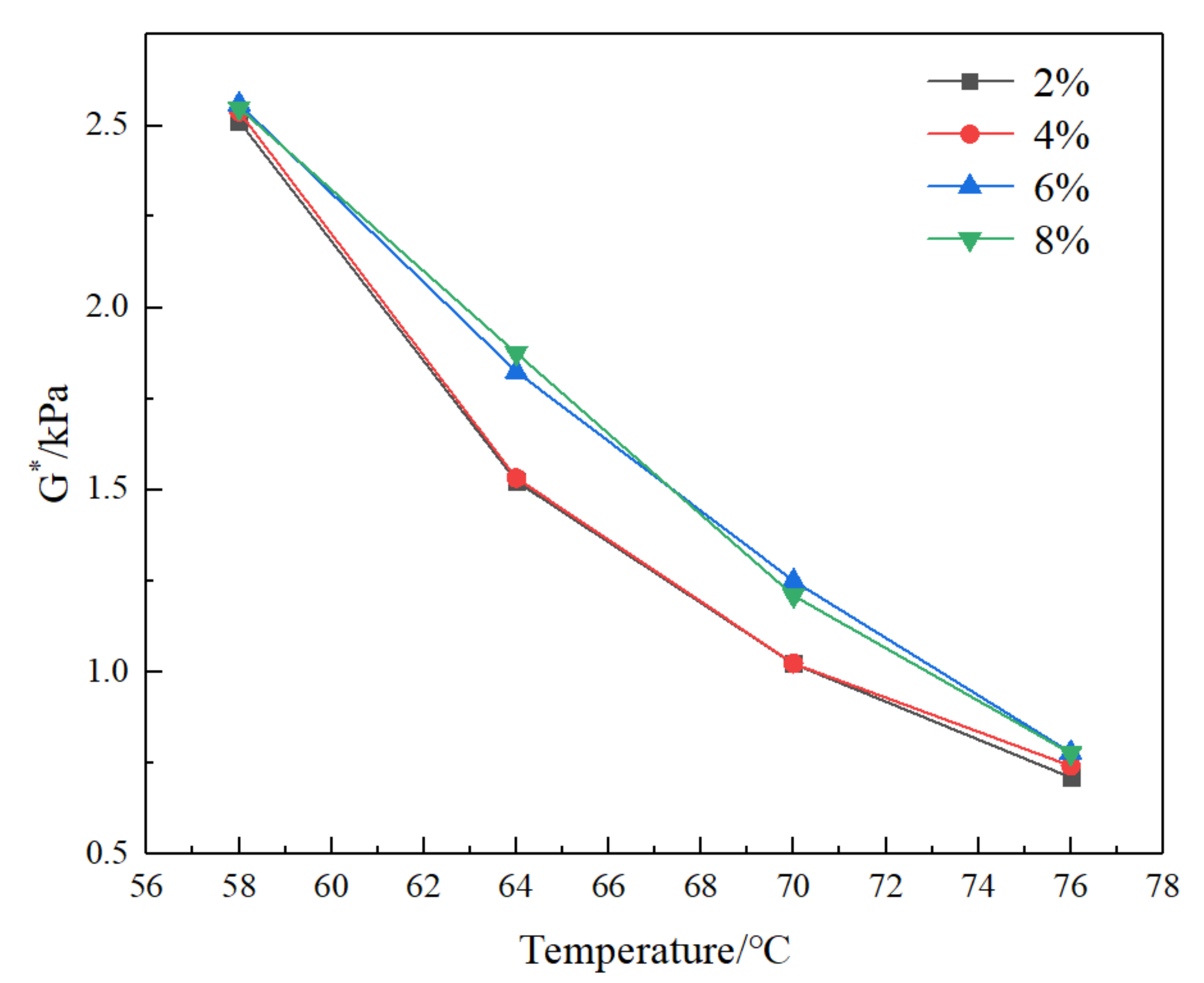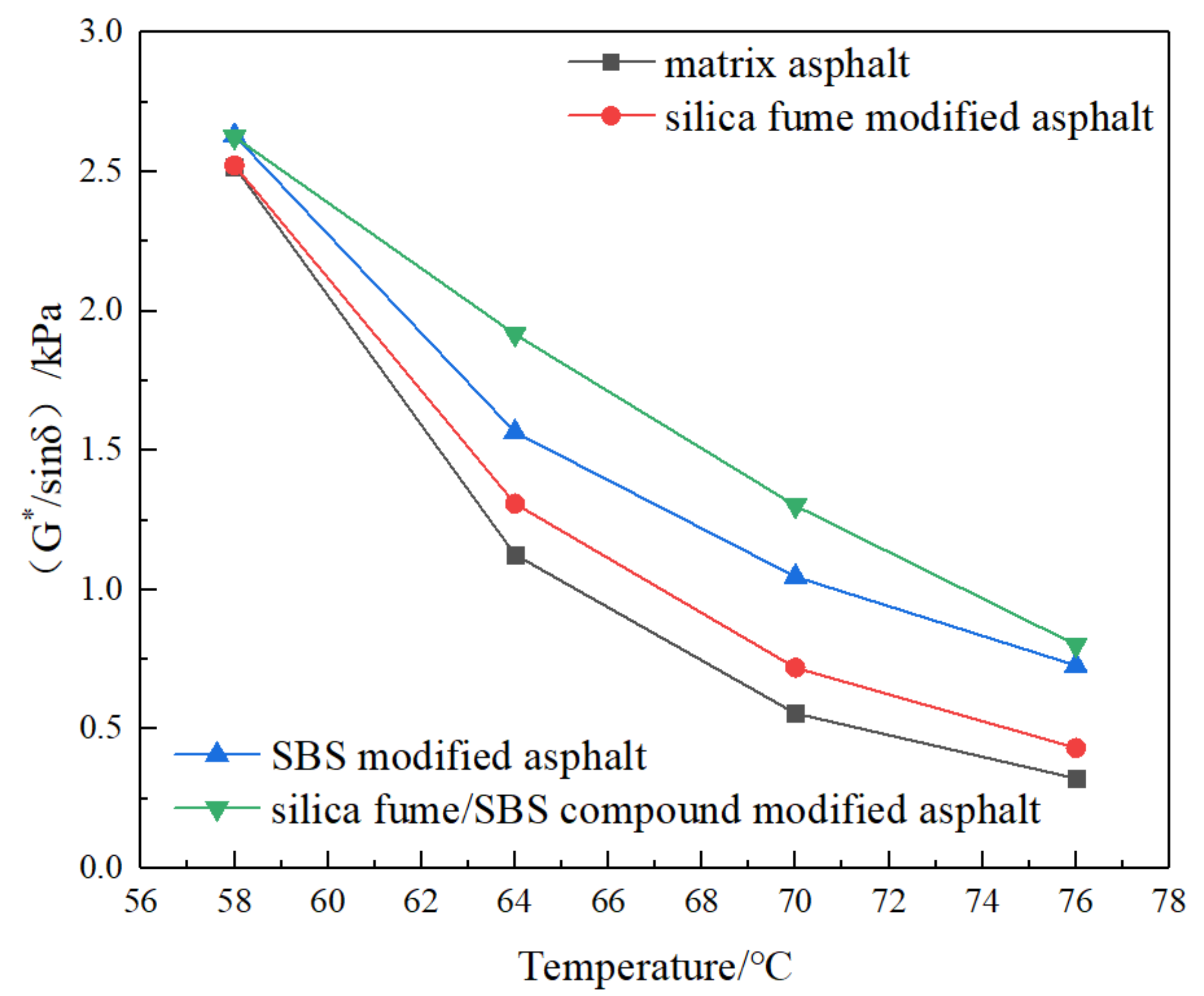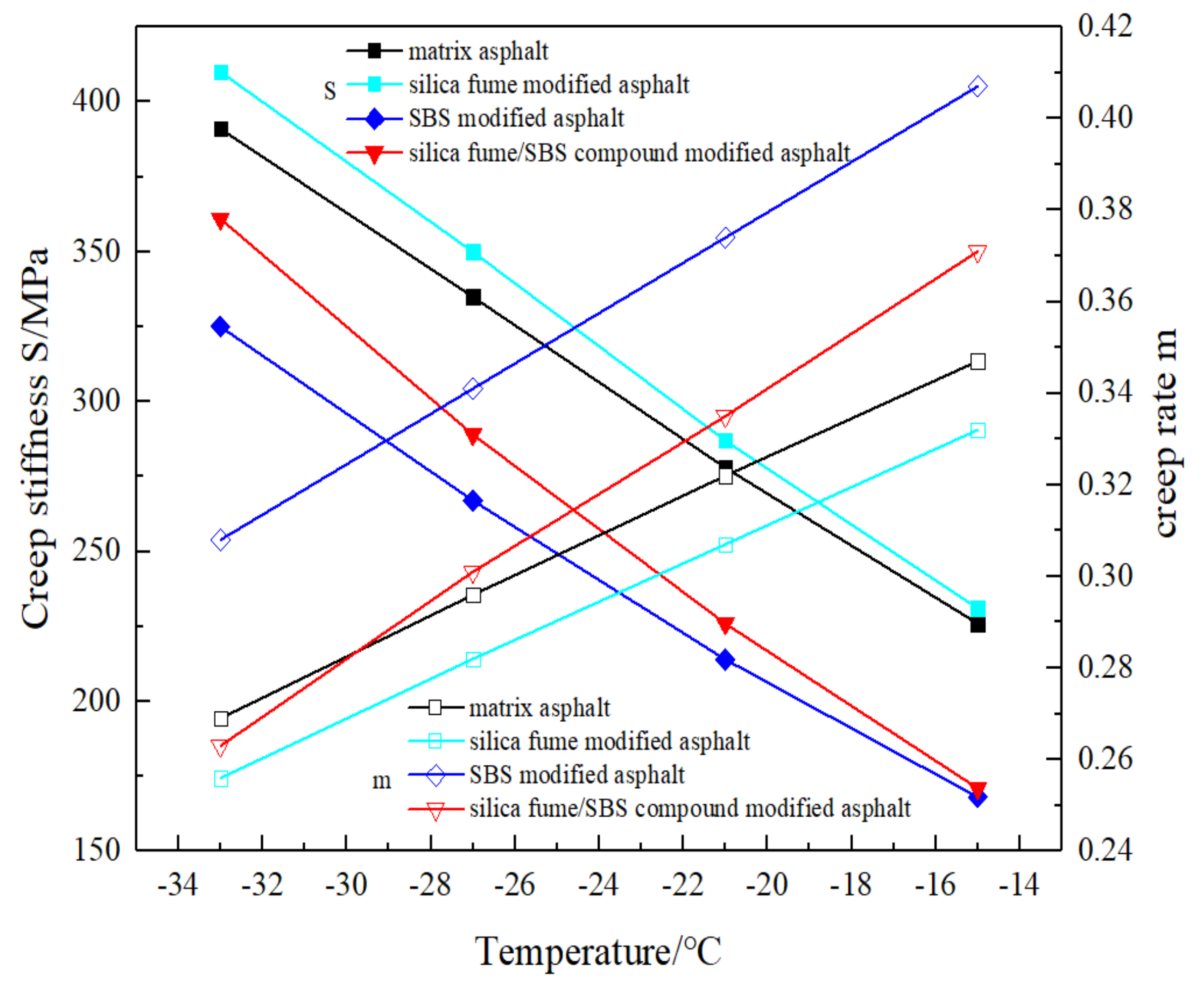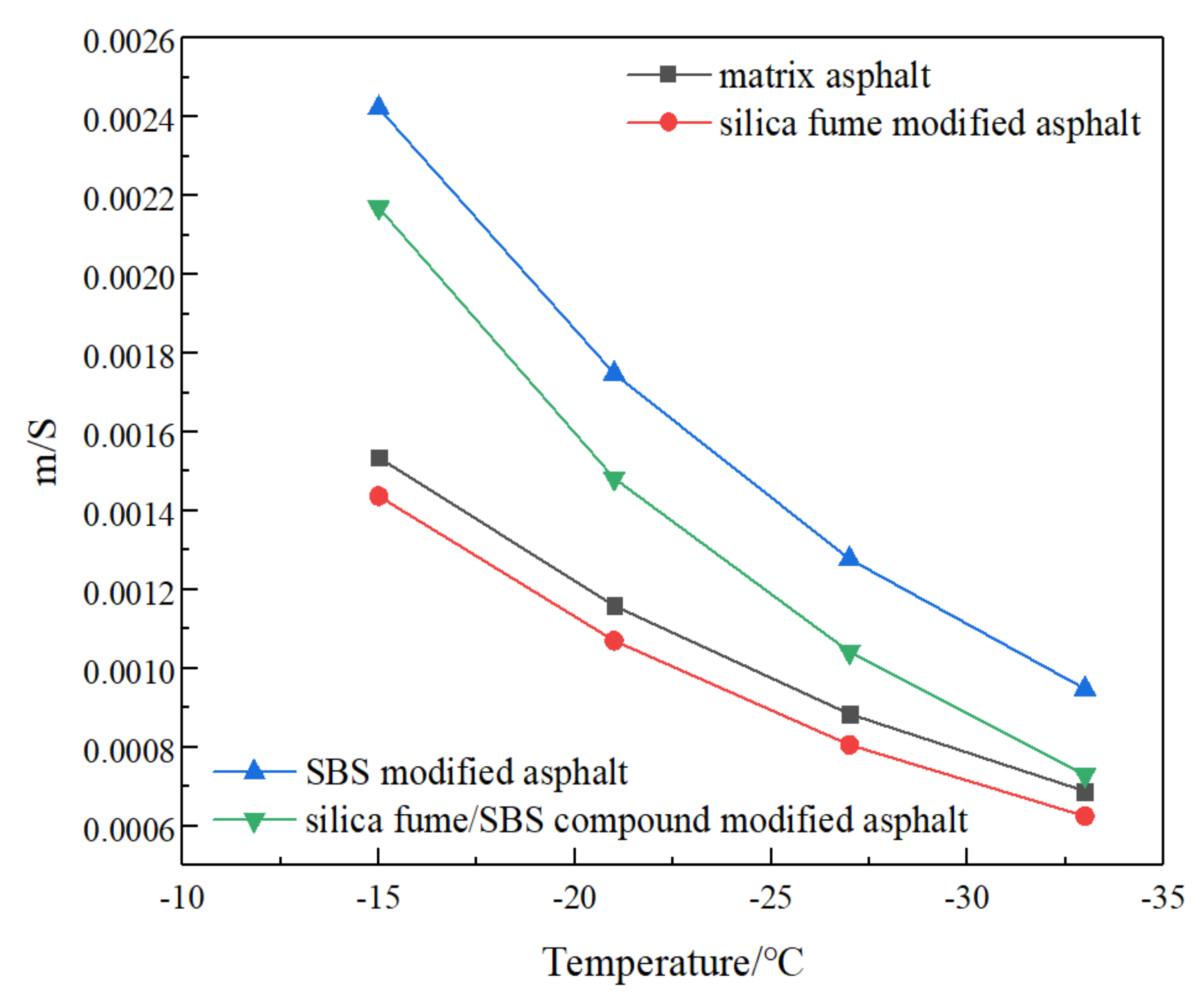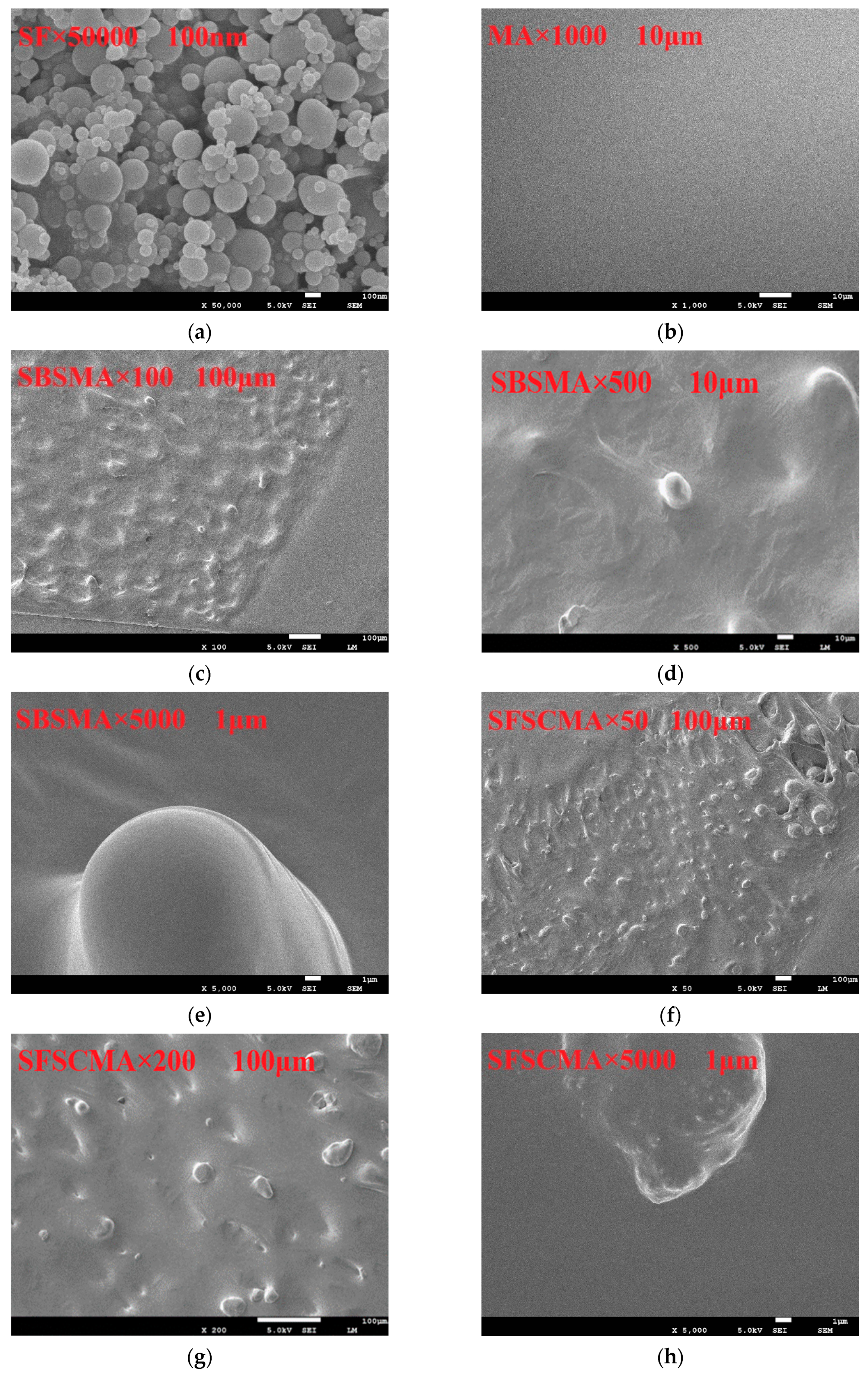1. Introduction
Silica fume (SF) is an industrial dust produced from ferrosilicon or metal silicon. It has the advantages of chemical corrosion resistance; good thermal stability and dimensional stability, excellent mechanical and electrical properties, and reinforcement. Silica fume (SF) is widely used in building, chemical, metallurgical, and other industries. For example, it can be used as cement or concrete admixture to improve the performance of cement or concrete, and mixing special concrete and compound cement with high strength, wear resistance, erosion resistance, corrosion resistance, permeability resistance, frost resistance and early strength, it has been well used in water conservancy, harbor wharfs, highways, airport runways, tunnels, and other fields. China is rich in silica fume (SF). Because of its unique microporous structure and better adsorption capacity, it has been used as a modifier to make modified asphalt.
SBS (Styrene-Butadiene-Styrene) modified asphalt (SBSMA) is in widespread use, owing to its good road function, but there are many shortcomings in SBSMA [
1,
2,
3,
4], for example, SBS is not compatible with matrix asphalt (MA), and it is easy to produce segregation when stored at high temperatures. At the same time, SBS is also a kind of high molecular polymer. Polymers will be degraded under the action of heat, oxygen, light, and mechanical force. Therefore, the degradation of the modifier will accelerate the aging of compound modified asphalt materials to a certain extent, thereby reducing the service life and anti-aging performance of the pavement.
When modified binder is used as a component of the asphalt mixture, the role of “silica fume (SF)” is played by the finest elements of mineral material, based on the excellent properties of SF modification and the shortcomings of SBS modification. In this paper, silica fume (SF) and SBS are added to the MA at the same time for compound modification to explore the performance of silica fume/SBS compound modified asphalt (SFSCMA), in order to promote the development of pavement materials and prolong the service life of pavement.
In past research, the application of silica fume is mainly concentrated in the field of concrete, to improve the mechanical properties of concrete. For example, Erhan Güneyisi [
5] et al. used silica fume (SF) instead of cement to prepare concrete containing silica fume. The research results show that the mechanical properties of rubber concrete are improved, and the strength loss rate of concrete is reduced by adding silica fume. Jin Liu [
6] et al. prepared a kind of compound mineral admixture on the basis of the mass ratio of steel slag to SF of 84:16. The effect of steel slag- SF compound mineral admixture on the hydration performance of cement-based composite binder, and its concrete performance, were studied. Mansour Fakhri [
7] et al. used silica fume instead of eight kinds of cement materials with different contents, to study the influence of waste rubber particles and silica fume on the mechanical properties of roller compacted concrete pavement. The application research of silica fume in concrete is far more extensive than the above examples, and many achievements have been made at home and abroad. However, the research on the application of silica fume in asphalt and its mixture is relatively little, and the research is relatively simple. For example, Yang Song [
8] et al. studied SF as an bitumen modifier in the laboratory. It was found that SF can improve the high temperature performance and temperature affection performance of asphalt and improve the high temperature stability and water stability of the mixture. Xu Wenyuan [
9] et al. analyzed the modification mechanism of SFSCMA by scanning electron microscopy (SEM) and infrared spectroscopy (FTIR). Luo Zixuan [
10] used the viscosity aging index and softening point to evaluate the aging resistance of SFSCMA. Cao Kai [
11] et al. studied the influence of SF on the high temperature and low temperature performance of SBS modified bitumen mortar through softening point, viscosity, DSR, and BBR trial. Shang Wenlong [
12] evaluated the rheological properties of aged silica fume modified asphalt (SFMA) by DSR test. Rim Larbi [
13] et al. used SF as a mineral admixture to improve the compressive strength of rap concrete. Chunfa Ouyang [
14] et al. prepared low density polyethylene (LDPE) modified asphalt with high temperature storage stability by adding silica into LDPE. The results show that silica can balance the poor polarity of asphalt and LDPE and improve the high temperature storage stability of asphalt.
In conclusion, there is little research on the fatigue nature and low temperature performance of SFSCMA at home and abroad. Although the research on high and low performance of SFSCMA is involved, the elevated temperature and microtherm property and mechanism are not combined. Therefore, in this paper, based on the existing research, DSR dynamic shear test, BBR bending beam creep test, and LAS (linear amplitude scanning) test are used to study the high and low temperature performance and fatigue performance of SFSCMA.
2. Materials and Methods
2.1. Materials
The matrix asphalt (MA) used in the test is Panjin 90# bitumen, Liaoning Province, China. The silica fume (SF) is provided by Anshan Anmei International Trade Industrial Development Co., Ltd., Liaoning Province, China. Styrene butadiene styrene block copolymer (SBS) is 4601 SBS modifier produced by China Guangdong Huizhou Li Guangdong Rubber Co., Ltd. In the SFSCMA, the SBS mass fraction is 4%, and the SF of 2%, 4%, 6%, and 8%, respectively, is compounded. The technical performance indexes of SF, MA, and SBSMA are shown in
Table 1,
Table 2, and
Table 3, respectively.
2.2. Methods
In the experiment, JRJ-300-I (Shanghai Specimen Model Factory, Shanghai, China) type high speed shear agitation emulsifier was used to prepare SFSCMA. The MA was heated to the melting state, then it was sheared with SBS and dried SF at 170–190 °C at high speed, with a rotating speed of 5000 r/min and a shearing time of 60 min. After shearing, it was stirred evenly for 30 min to prepare SFSCMA. The penetration test, ductility test, softening point test, DSR test, and BBR test were carried out for MA, SBSMA, SFMA, and SFSCMA.
For the penetration and ductility test (JTG E20-2011), three samples of composite modified asphalt with silica fume proportion of 2%, 4%, 6%, and 8% were prepared, respectively. The penetration test temperature was 25 °C, the load was 100 g, and the time was 5 s. The ductility test temperature was 5 °C, the tensile rate was 5 cm/min. For the softening point test (JTG E20-2011), two samples were prepared for each proportion of asphalt samples.
Regarding the Dynamic Shear Rheological (DSR) Test—in this article, a stress control pattern was employed. The stress level was held at 0.1 kPa, and the angular frequency was 10 rad/s. The diameters of the specimen were 25 mm (the thickness is 1 mm) and 8 mm (the thickness is 2 mm) (AASHTO T315-09); two parallel tests were carried out for each proportion of asphalt.
Regarding the Bending Beam Rheometer (BBR) Test—the creep stiffness modulus S and creep rate m can be acquired through BBR trail, and afterwards the microtherm properties of bitumen can be analyzed by these two parameters. The size of the test piece is length × width × thickness (102 × 12.7 × 6.35 mm) (AASHTO T313-09); two parallel tests were carried out for each proportion of asphalt.
Regarding the LAS (linear amplitude scanning) test—according to AASHTO TP101-14, the LAS test is divided into two parts: frequency scanning and amplitude scanning. In frequency scanning, the frequency scanning range of the sample is 0.2–30 Hz, and the strain level is 0.1%, so as to determine the rheological properties of asphalt and obtain the damage analysis parameters; in the amplitude scanning, the loading frequency is 10 Hz, the loading time is 300 s. The loading amplitude increases linearly from 0.1% to 30.0%, and the test temperature is 25 °C. The specific calculation method is as follows:
The storage modulus
and the angular velocity ω obtained from the frequency scanning test taken as logarithm, and the formula is obtained as follows:
Rheological parameters of asphalt
:
Damage parameter
D:
where
,
is complex shear modulus with time in amplitude scanning,
is initial complex shear modulus,
is strain at time
t, and
t is time.
When time is fixed,
C(t) and
D(t) meet the formula:
Failure
:
where
is
C(t) corresponding to the maximum stress.
Fatigue equation parameters
A and
B:
where
f = 10 Hz,
k = 1 + (1 −
C2) α,
B = 2α.
Finally, the fatigue equation is obtained:
where
is the maximum strain.
Take the logarithm of both sides of the fatigue Equation (7) to get:
Regarding the SEM (scanning electron microscope, Hitachi TM3030, Tokyo, Japan) test—in this experiment, the test temperature was 20 °C, and the relative humidity was 50%. According to the operation and test procedures of TM3030 and JB/T 6842-1993, the SEM test of the initial specimen and different bitumen were carried out.
